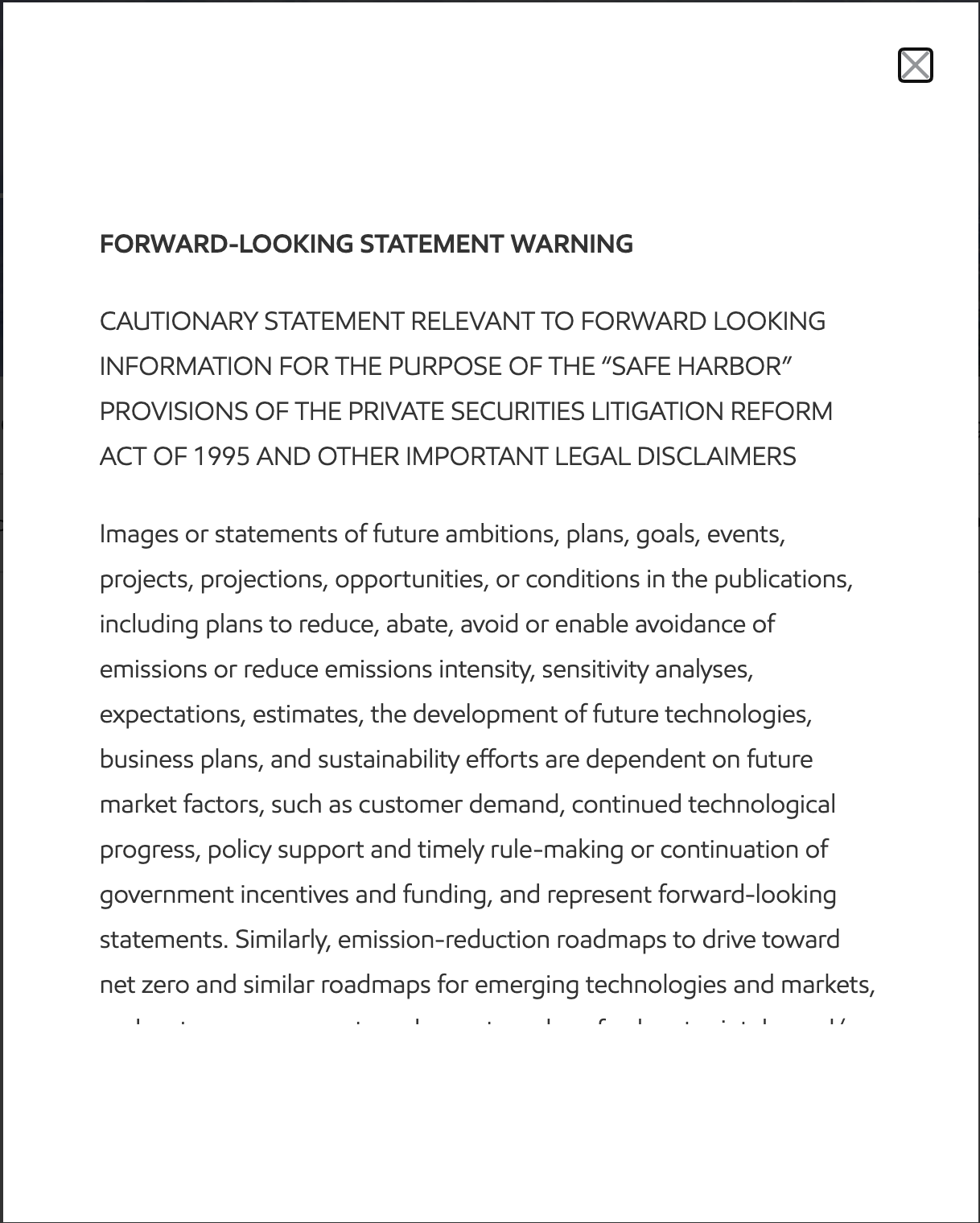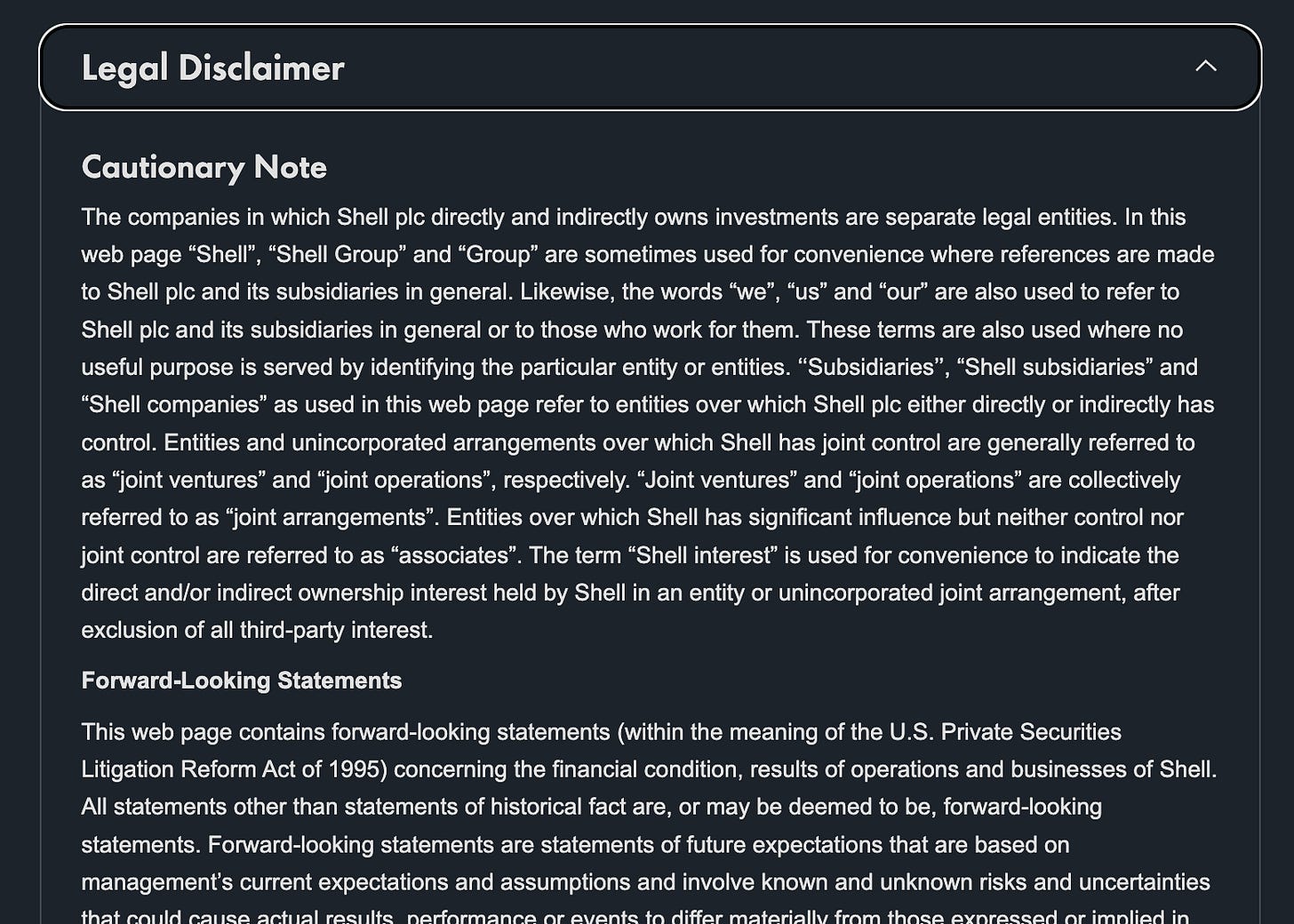TCC #52: Are the suits the problem?
How legal concerns are stifling genuine corporate sustainability communications
Growing up, my dad told me lawyers were barnacles — clinging to whatever cause would earn them the highest fee.
As an adult I find that assessment a little harsh. I have a lot of respect for the legal system and the honest and hardworking people who work within it. Also, Obama is a lawyer.
But I do have a problem with the way legal concerns are increasingly getting in the way of genuine sustainability action and communications.
I see this happening in three main ways.
#1 — Goal-setting and disclaimers
Legal teams have all but invalidated even the most achievable of sustainability commitments through copious disclaimers. Companies shout their sustainability goals from the rooftops, but you can’t miss the multi-page disclaimers designed to make sure that you know that, well — they don’t actually have to follow through with these goals.
I’ve never had much patience for fine print, but legal disclaimers on sustainability communications are truly the worst.
You can’t even get onto ExxonMobil’s sustainability page without first addressing this lengthy disclaimer:
Shell’s is just as long and almost as front-and-center.
When Meg and I ran our initial analysis on the top 100 largest companies’ sustainability reports from 2024 (to be released in the coming weeks), we expected to find that legal disclaimers had increased in size. Every report we flicked through seemed weighed down by its disclaimers.
As it turned out, the length and content of disclaimers have stayed pretty much the same over the past few years. Perhaps they stuck out more in this past reporting season because many companies said a lot less about their sustainability progress, yet the disclaimers didn’t shrink. Disclaimers aren’t getting longer, but they are taking up a bigger portion of the conversation.
#2 — Greenhushing
And this leads me to the second way I see legal teams getting in the way of climate communications, which is the gag order that many companies seem to be under right now.
In our analysis, Meg and I were most interested to see how many companies were pulling right back on previous years’ reporting trends, and we weren’t disappointed. Roughly 20% of companies drastically changed their tune this year, swapping out 100+ pages of shiny graphics and weasel-word commitments with a handful of pages containing nothing but data tables. Often these ‘environmental updates’ or ‘factsheets’ measured just 12 or so pages.
On its surface, this trend feels like a win, especially for those of us who criticized the vague ambitions and unverified statements in previous reporting years. However, Meg and I believe that the prioritization of quantitative over qualitative data is not done out of a commitment to accurately educate readers so much as a fear of being called out for greenwashing.
Companies are so afraid to say the wrong thing that many have stopped saying much at all.
Data tables are not the holy grail of clear communication. In fact, data dumping is one way to make it harder for general readers to understand what’s actually going on and whether companies are making genuine progress toward their goals. Some narrative is required to contextualize where companies are on their journeys — and the very short reports we saw lacked this basic contextualization.
And greenhushing — staying silent on climate progress — is hardly virtuous. For these top 100 companies, greenhushing represents a failure to take a leadership stance on ESG and sustainability issues. When the bigger companies stop talking about their climate action, the smaller companies have less to aspire to. It also means investors can’t make informed decisions about where to invest their capital. It’s just as bad as gatekeeping information about your sustainability initiatives so that you can turn it into a ‘competitive advantage’ (on a burning planet).
South Pole’s Destination Zero report, released early last year, noted that keeping quiet about climate action is setting us back.
“Make no mistake, it is the committed corporate climate leaders who will blaze the trail down which the climate laggards will eventually be frog-marched by regulators. Which is why, more than ever, it is time for all companies to meet the moment, to step up and, importantly, speak up, on climate action.” — John Davis, Interim CEO, South Pole
When climate-conscious companies hide their progress is that they give a greater share of voice to the companies that aren’t taking climate seriously, but claim to. When Exxon’s report is twice the length of Netflix’s, it’s hard to really grasp what’s going on.
#3 — Saying sorry
Rounding it off with the third way legalese gets in the way of proper climate communications: it puts companies in the awkward position of not being able to say they’re sorry when things go wrong, because saying sorry implies an admission of guilt.
We can’t blame this phenomenon entirely on the suits. Companies are pretty scared to admit to any failures in the realm of sustainability due to reputational risk alone, which is why they’ll quietly drop targets, say nothing when the SBTi delists them, and frame failures as part of a changing of goals or a shifting or priorities. (Meg and I believe there’s more target-dropping going on than most of us know about; it simply isn’t being disclosed).
But certainly, few lawyers want their companies or clients to admit to the real truth when environmental claims are brought against them. That puts communicators in the tough position of having to avoid or gloss over very important context in their sustainability communications.
So what should we do about all this?
We certainly can’t stop the suits from doing their jobs. And we can’t just blithely expose our companies or clients to legal risk (not in this litigious society!). But we do need to start thinking about how to check the boxes without hampering real climate action and communication.
Sustainability communicators should think carefully about the effect that long and burdensome disclaimers have on their voluntary sustainability claims. Lofty sustainability commitments bookended by suspicious fine print is the equivalent of someone saying, “I love you, but…” Besides — when Exxon and Shell love them so much, what does that tell you?
Sustainability communicators should also speak up internally about the fact that data tables are not the antidote to greenwashing, and greenhushing is not the virtue it appears to be.
And if it comes down to it, sustainability communicators should help their company address failures and mistakes honestly.
It’s not easy being a sustainability communicator. On one shoulder, you’ve got a marketing team desperate to shout about anything and everything. On the other, you’ve got a legal team that would prefer you didn’t even have a website, let alone a sustainability report. Far too much liability!
The winds continue to shift in the world of corporate sustainability, and we’ll have to keep readjusting our sails.
If you’re interested in reading the full report on our analysis of the 100 largest companies’ ESG reports, click subscribe and you’ll be notified when it’s released 🙃





